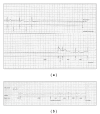Inappropriate asystole detection in early postoperative phase after loop recorder implantation
- PMID: 22347628
- PMCID: PMC3262500
- DOI: 10.5402/2011/146062
Inappropriate asystole detection in early postoperative phase after loop recorder implantation
Abstract
The implantable loop recorder is a useful diagnostic tool for patients with unexplained syncope. The capability to automatically detect and store arrhythmic events, implemented in the last generations of these devices, can further improve the diagnostic yield, but this feature can be compromised by inappropriate detection of false arrhythmias. We herein report the case of a patient in which several inappropriate activations of long-lasting asystole occurred in the two days following the implant, probably because of an intermittently loose contact between the device and subcutaneous tissue for a small pocket haematoma.
Figures


References
-
- Brignole M, Alboni P, Benditt DG, et al. Task Force on Syncope, European Society of Cardiology. Guidelines on management (diagnosis and treatment) of syncope-Update 2004. Europace. 2004;6:467–537. - PubMed
-
- Giada F, Gulizia M, Francese M, et al. Recurrent unexplained palpitation (RUP) study-comparison of implantable loop recorder versus conventional diagnostic strategy. Journal of the American College of Cardiology. 2007;49(19):1951–1956. - PubMed
-
- Ng E, Stafford PJ, Ng GA. Arrhythmia detection by patients and auto-activation in implantable loop recorders. Journal of Interventional Cardiac Electrophysiology. 2004;10(2):147–152. - PubMed
-
- De Cock CC, Spruijt HJ, Van Campen LMC, Plu AW, Visser CA. Electromagnetic interference of an implantable loop recorder by commonly encountered electronic devices. PACE—Pacing and Clinical Electrophysiology. 2000;23(10 I):1516–1518. - PubMed
Publication types
LinkOut - more resources
Full Text Sources

